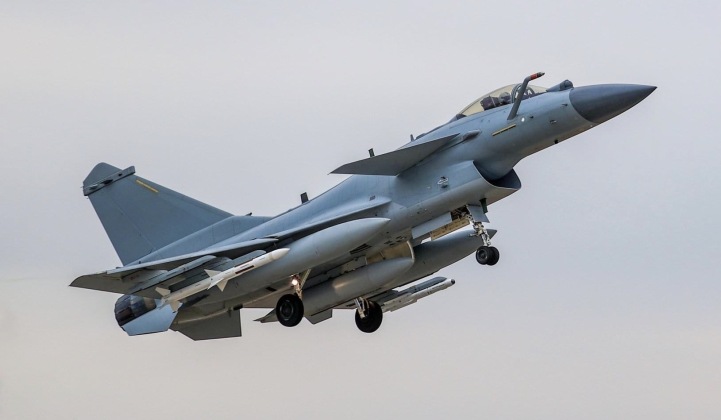Replacing the F-16: Will Pakistan’s Top Fighter Squadron Transition to Chinese J-10Cs?
June-22nd-2021
Chinese J-10C with PL-10 and PL-15 Missiles
The Pakistani Air Force’s combat jet acquisitions for over a decade have centred around the
JF-17 Thunder fighter program, which has been pursued jointly with China and has seen the country acquire fighters both from Chinese production lines and from those located in Pakistan itself. Before the JF-17, Pakistan’s Air Force was comprised primarily of ‘very light’ third generation fighters and attack jets such as the J-7, Mirage III, Mirage 5 and Q-5, with a single elite squadron comprised of slightly heavier but still lightweight fourth generation F-16A/B Fighting Falcons. While the JF-17 has allowed Pakistan to replace the pre-fourth generation jets in its fleet with a ‘very light’ fourth generation fighter, which although in many ways more sophisticated than the F-16 has a much smaller engine and much lower operational cost, the JF-17 is not expected to replace the F-16 itself in service. Pakistan’s F-16 fleet is fast ageing, however, with the large majority comprised of F-16A/B fighters acquired in the early 1980s. This old F-16 variant has been retired by the majority of countries, with Egypt and Israel recently retiring their fleets, and only Taiwan and Venezuela expected to continue using them due to an inability to procure replacements.

Pakistani Air Force F-16 Leads Mirage III and JF-17
Pakistan was the third country in the world to field the F-16 after the United States and Israel, and has upgraded the fighters over time including integrating modern AIM-120C air to air missiles onto them. A number of factors such as metal fatigue, however, mean that operational costs will only continue to rise and there will be growing pressure to retire the aircraft in favour of a more modern fighter - likely a lightweight or medium weight aircraft which will be larger and more capable than the JF-17. When Pakistan does so it will likely replace the jets with a non-American fighter class, as the U.S. is highly unlikely to offer a more capable aircraft such as the F-18E or F-35A. Although some unverified reports have indicated that Pakistan could consider purchasing MiG-35 fighters from Russia, this is unlikely due to Russia’s close defence ties with India, and the fact that India already operates MiG-29UPG jets which are in many ways similar, albeit much less capable, than the
MiG-35. As such the most likely options are either that Pakistan will wait until its fifth generation Project AZM program being pursued with China can produce fighters, or that it will purchase Chinese J-10C fighter jets. The
J-10C has notably been deployed to Pakistan in the past for joint training exercises, and reportedly made a very strong impression due to its advanced capabilities.
Chinese J-10C Fighter
The J-10C entered service from 2018, and like the F-16 it is a single engine lightweight fighter. Having been designed several decades after the F-16, the J-10 is a much more advanced design
boasting advantages in almost all parameters, including a higher speed, lower radar cross section and much greater manoeuvrability. The J-10C is the latest and most capable J-10 variant, and uses thrust vectoring engines for enhanced manoeuvrability - something no Western fighter other than the F-22 does. It benefits from stealth coatings for improved survivability. The aircraft uses a modern AESA radar paired with some of the world’s most capable air to air missiles, the PL-15 and
PL-10, the former which is one of just two in the world confirmed to use an AESA radar for guidance. These missiles will also be
deployed by upcoming improved variants of the JF-17.
J-10C Equipped for Air Defence Suppression with YJ-91 and PL-10 Missiles
The J-10C would provide Pakistan with by far the most capable combat jet in its fleet, and benefits from a much lower operational cost and lower maintenance needs than the ageing F-16A airframes. Its access to YJ-91 cruise missiles provides much a much more dangerous air to ground capability than any Pakistani fighter. With the J-10C having reportedly proven capable of
outperforming heavyweight Russian jets from the Flanker family, due largely to its more advanced radar and missiles, the Chinese-built fighter would provide an
effective means of countering India’s most dangerous fighter class the Su-30MKI. A Pakistani J-10C purchase remains by far the most likely option should the country look to acquire
new combat jets other than the JF-17, with China potentially providing the aircraft on highly favorable terms due to the close strategic partnership between the two countries. At least until the F-35 moves beyond its current
very limited initial operating capability to eventually
become fully operational, the J-10C will be considered the world’s most capable single engine fighter in overall performance.
Replacing the F-16: Will Pakistan’s Top Fighter Squadron Transition to Chinese J-10Cs? (militarywatchmagazine.com)











